IJCRR - 8(2), January, 2016
Pages: 65-73
Date of Publication: 22-Jan-2016
Print Article
Download XML Download PDF
DELAYING POSTHARVEST RIPENING OF TOMATO (LYCOPERSICON ESCULENTUM MILL.) BY USING 2, 4-DICHLOROPHENOXY ACETIC ACID
Author: Duguma Dibbisa, Meseret C. Egigu, Manikandan Muthuswamy
Category: Healthcare
Abstract:The aim of this study was to evaluate the roles of plant growth hormone (PGH); 2, 4-D to delay tomato fruit ripening under laboratory conditions so as to improve its shelf life and prevent its postharvest loss before reaching consumers. The experimental design was complete random design with three treatment levels of unripe healthy tomato immersed in (30, 50 and 100ppm) of 2, 4-D. The control fruits were immersed with distilled water. All treatments were done in three replications. Quality parameters that serve as indicators of ripening stages such as weight loss, pH, titratable acidity, total soluble solid, pigments (chlorophyll a, chlorophyll b and total chlorophyll), lycopene, total carotenoids, reducing and total sugars were measured over three weeks on weekly basis. Results showed that almost all measured parameters were significantly affected by the application of 2, 4-D; 2, 4-D was found to prevent quality deterioration and rapid ripening of tomato fruits. The effectiveness of PGH appeared to be high at their lower concentrations. Therefore, 2, 4-D may be useful at lower concentrations to delay ripening of tomato fruits and avoid rapid postharvest loss if applied on healthy unripe tomato fruits. However, their impact on other nutritional aspects and human health must be further investigated before application.
Keywords: Ethylene, Plant growth hormone, Postharvest treatment, Senescence, Tomato
Full Text:
INTRODUCTION
Tomato (Lycopersicon esculentum Mill.) has become the most widely grown vegetable in the world being recognized as a reach source of vitamins and minerals. It is also among the most important vegetable crops in Ethiopia. The total production of this crop in the country has shown a marked increase since it became the most profitable crop providing a higher income for small to large scale farmers compared to other vegetable crops (Lemma et al., 1992). However, large portions of tomato it would be lost worldwide after harvest, the major of them are in sub-tropical countries (Javid, 2009). Tomato is one of the important fruit and vegetables highly cultivated in northern and central rift valley areas including Somali Regional States of the country. In recent years, commercial tomato production has significantly expanded since national agricultural strategies began favoring high value cash crops to enhance the need of Growth and Transformation Plan (GTP) of the country (Central Statistical Agency, 2011). The supreme important of tomato production in worldwide is; contributes versatile health benefits and the status of it as a functional food emphasize the need in the daily diet of all, because it is rich in minerals, essential amino acids, sugars, dietary fibers and it is considered to be fairly high in vitamins, vitamin C, flavonoid, lycopene and β-carotene with potential for better quality processing (Naika et al., 2005). To date there is no much information before on preventing postharvest losses of fruits and vegetables in Ethiopia. This study is therefore designed to delay post-harvest fruit ripening of tomato by plant growth regulator (2, 4-D) with different concentrations so as to reduce its loss after harvest until it reaches end users.
MATERIALS AND METHODS
Description of Experimental Site This study was conducted in April 2014 to June 2014. The experiment was carried out at Haramaya University Genetic and Molecular Biology and Microbiology Laboratories. Haramaya University is located at 515 km East of Addis Ababa, Ethiopia at an altitude of 2011 meters above sea level with 9.00 N latitude and 42.00 E longitude. The place has a mean maximum temperature of 25.50 C and mean minimum temperature of 12.260 C (Tekalign, 2005).
Experimental Materials Fruits of known tomato cultivars were obtained from local farmer’s field. The mature green (MG) and Breaker (BR) fruits were obtained and immediately transported in a polystyrene box to the genetic; molecular biology and microbiology laboratories of the university. Fruits were left for 22 hrs (after harvest) at room temperature in order to stabilize ethylene evolution caused by wounding.
Experimental Design and Treatments The experimental design was completely randomized design with three treatments in three replications. Of the collected tomato samples, 80 tomato of uniform size with no bruises or damage were selected for treatments with 30ppm, 50ppm and 100 ppm of 2, 4-D. Fruits were surface sterilized with sodium hypochlorite solution (500 ppm) for 10 minutes so as to reduce fungal infection and air-dried for approximately 15 minutes. After surface sterilization, fruit treatment was done by immersing eight tomato fruits per treatments in a jar containing equal volume of different concentrations of each solution for 15 minutes. The control one was immersed in distilled water in the same way. The fruits were then stored in a carton in laboratory at 13±2ºC. Thereafter, fruits were assessed for different quality parameters such as physiological weight loss, total soluble solids, titratable acidity, ascorbic acid, lycopene, total carotenoids, and chlorophylls, reducing sugars and total sugar every week for three weeks as follows.
Data Collection and Analysis Physiological Loss of Weight Weight loss was determined by using method indicated by Akbudak, (2007) by periodically (on 7th, 14th, and 21st days of storage) weighing tomato fruits by digital balance (Denver Instrument XL-1810). Percentage weight loss was calculated using the following formula.
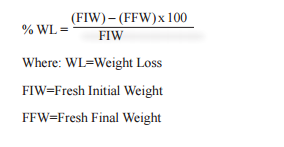
Ascorbic Acid Analysis The ascorbic acid content was determined by the 2, 6- dichlorophenol indophenol methods A.O.A.C, (2000). An aliquot of 10 ml tomato juice extract was diluted to 50 ml with 3 percent metaphosphoric acid in a 50 ml volumetric flask. The aliquot was then centrifuged (Model, Z300, 580W, 3052 Nm, German) for 15 minutes and titrated with the standard dye to a pink end point (persisting for 15 second). The ascorbic acid content was calculated from the titration value, dye factor, dilution and volume of the sample.
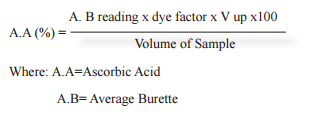
pH, Titratable Acidity and Total Soluble Solid Measurements The digital pH meter (model–ME 962P, India) was used to determine the pH value of tomato fruit samples as per the method described by A.O.A.C, (2000) while the titratable acidity was determined by a standard titrimetric method. For the determination of titratable acidity, 20 grams of extracted tomato juice was mixed with 250ml of distilled water. In the presence of phenolphthalein as an indicator, the mixture was titrated by adding 0.1 N NaOH until the break of light pink colour (pH 8.2) was observed for 15 seconds. The volume of NaOH added to the solution was multiplied by the correction factor of 0.064 for the calculation of titratable acidity as percentage of citric acid.
Titratable acidity was expressed as percentage of citric acid (A.O.A.C, 2000). The total soluble solid content of the fruit was determined by using refractometer (Atago Co., Tokyo, Japan). For this, the homogenous sample was prepared by blending the tomato flesh in Kenwood blender, (Model, BC311 P.R.C. China). The sample was then thoroughly mixed and a few drops were taken on prism of refractometer and direct reading was taken by reading the scale and in expressed as ºBrix as described in (A.O.A.C, 2000).
Ethylene Production Determination Five fruits per treatment were sealed in a glass jar (225 ml) for 30 min. Thereafter, 1ml of the gas was withdrawn from the overhead space using a 1ml syringe. Ethylene concentration was determined using instrument called gas chromatograph (Model, CP, 9002, German) equipped with a flame ionization detector and a stainless column packed with activated alumina. The oven and detector temperatures were 80 and 120ºC respectively. Known concentration of pure ethylene was used to confirm the identity of ethylene in the sample and was expressed as µKgL-1h-1 (Arnold et al., 2005).
Determination of Chlorophylls, Lycopene and Total Carotenoids Determination was based on a Spectrophotometric analysis following the method developed by Nagata, (1992) for the simultaneous determination of chlorophylls and total carotenoids in tomato fruit. Sixteen millilitres of acetone–hexane (4:6) solvent was added to1g of tomato homogenates. For this, the homogenous sample was prepared by Kenwood blender, (Model, BC311 P.R.C. China). The homogenate was centrifuged at 5000 rpm using centrifuge (Model, Z300, 580W, 3052 Nm, German) for 10 minutes at 20°C. Then after an absorbance was measured at 663, 645, 505, 663.6, 646.6,470 and 453 nm in a Jenway model 6100 spectrophotometer. Lycopene, total carotenoids and chlorophyll contents were calculated according to the equations indicated below, and the final results were expressed as µg/g for chlorophylls and mg/g for antioxidants.

Sugar Analysis Reducing and total sugars were estimated by using the techniques of Seyoun, (2007). Liquidized fresh tomato (10g) was added to 15ml of 80 percent ethanol, mixed and heated in boiling water bath for sufficient time until the ethanol odor went off. After extraction, 1ml of saturated Pb (CH3 COO) 2 and 1.5ml of NaHPO4 were added and the contents were mixed by gentle shaking by vortex shaker. After filtration, the extract was made up to 50 ml with distilled water. An aliquot (1ml) extract was diluted to 25ml with 1ml copper reagent in a test tube and heated for 20 minutes in a boiling water bath. After heating, the contents were cooled under running tap water without shaking.
Arsenomolybdate colour reagent (1ml) was added, mixed, and made up to 10ml with distilled water and left for about 10 minutes to allow colour development. Thereafter, the absorbance was determined using spectrophotometer at 540 nm. For total sugar determination, sugar was first hydrolyzed with 1N HCI by heating at 70o C for 30 minutes. After hydrolysis, total sugar was determined following the same procedure employed for the reducing sugar. A blank was prepared using distilled water.

Data Analysis The data obtained from the study were analyzed using SAS 9.1.3 statistical software. Mean separation was performed by using least significance difference (LSD) at (P ≤ 0.05) level. The data were analyzed using Bartlett’s test.
RESULTS AND DISCUSSIONS
Effects on Physiological of Weight Loss
When measured after one week of storage, there was a significant difference observed between the different concentrations of 2, 4-D treated tomato fruits and their controls in weight loss. Among the different concentrations of 2, 4-D treated tomato fruits, lower weight loss were observed in 50ppm and 100ppm concentrations, whereas higher weight loss were observed in 30ppm concentration. Weight loss from control tomato fruits was significantly higher than both 2, 4-D treated tomato fruits (Figure 1). On the 14th days of storage, there was a significant difference between the difference concentrations in 2, 4-D treated tomato fruit and their control in weight loss. A comparison observed within their difference concentrations of by 2, 4-D treated tomato fruits at day 14th revealed the same trend with day seven treatments. However, the amount of weight loss in the control of tomato fruit was gradually increasing and it was significantly higher than of by 2, 4-D treated tomato fruits (Figure 1). Tomato fruits treated with by 2, 4-D showed reduction in weight loss significantly as compared to control group after 21st days of storage. There was a significant difference between the difference concentrations of 2, 4-D treated tomato fruit and their control in weight loss.
However, gradual weight losses of tomato fruits were observed in control group throughout the days of storage (Figure 1). The weight loss of tomatoes fruits may happen mainly due to transpiration and respiration Bhowmik, (1992). Respiration causes a weight reduction because a carbon atom is lost from the fruit each time as carbon-dioxide molecule was produced from an absorbed oxygen molecule and evolved into atmosphere Bhowmik, (1992). As compared to the control fruits, the less weight loss observed by 2, 4 -D treated tomato fruits accords with results of Lester, (1999) who reported that the application of calcium chloride to plums maintains membrane integrity and reduces weight losses in fruits and vegetables. The reduction in less weight loss of fruit and vegetable was due to their anti-senescent processes (Sudha et al., 2007).
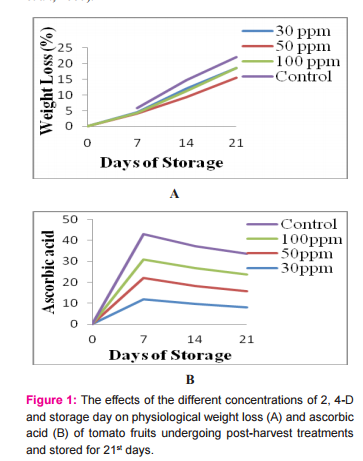

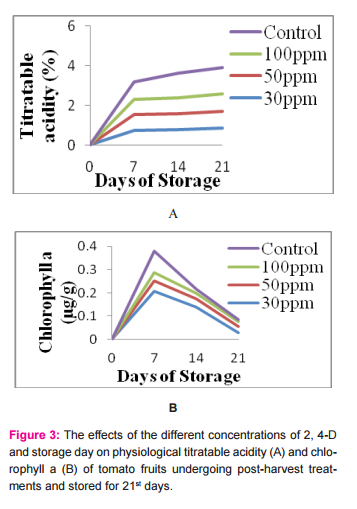
Effects on pH Values On the 7th day of storage, there was insignificant difference between the different concentrations of 2, 4-D treated tomato fruits and their controls in pH values. However, the pH value in control tomato was significantly higher than that of both 2, 4-D treated fruits. The pH value did vary between the three different concentrations of 2, 4-D for tomato fruits treatments. Among the three different 2, 4-D concentrations, higher pH value was seen in 30ppm and the lower pH value was seen in 50ppm and 100ppm concentrations respectively (Figure 2).
On the 14th day of storage, there was a significant difference observed between the different concentrations of 2, 4-D treated tomato fruits in pH values. However, a significant different was observed between 2, 4-D treated fruits and their controls. Tomato fruits treated with the highest 2, 4-D concentrations had yield higher pH value than the lower. On the 21 days of storage, pH value showed decreased and the obtained results were statistically significant different (P≤ 0.05) (Figure 2). Generally, the pH values of tomato fruits treated by 2, 4-D was found to decrease and relatively to be lower than that of the controls group in all the days of storage. This study, therefore, showed that treatment of tomato fruits with 2, 4-D has significant effect on pH, and their effectiveness is in concentration dependent manner. The finding of this study is reliable with the findings of Andrea et al.,(1999) who reported that application of calcium chloride on apple fruits reduces the pH of fruits during their storage period.
Effects on Ascorbic Acid On the 7th day of storage, there was significant difference in ascorbic acid (AA) contents between tomato fruits treated with different concentrations of 2, 4-D and their control. Among the 2, 4-D treatments the lower value of ascorbic acid content was seen in 50ppm (9.66%) and 100ppm (7.96%) concentrations respectively and higher amount of ascorbic acid was found in 30ppm (11.90%). Ascorbic acid content was dramatically decreasing with increasing concentrations of 2, 4-D treated tomato fruit (Figure 1). The same trend was seen with the treatment at day 14th (Figure 1). On the 21st days of storage, there was a significant different has been seen between the concentrations differences in 2, 4-D treated tomato fruits and their control in ascorbic acid contents.
The content of AA was decreased during ripening stage but not as much as the control group. This decrease might be due to its antioxidant function when the ripening cells absorb high amount of oxygen; this was the result of an increase in respiration, which was the characteristic of climacteric fruits (with an autocatalytic synthesis of ethylene) (Macheix et al., 1990). The difference in the ascorbic acid levels among fruits in the different treatments could be due to the effects of respective treatments on ripening as described for other parameters in the earlier sections. In case of this study on 21st day fruits grouped under control were highly degraded while compared to the 2, 4-D treatments.
The result of this study is agreed with the report of ?16? and ?17? who indicated a decline in AA contents of tomato fruits during ripening. The slow degradation of ascorbic acid by 2, 4-D might be due to the lowering of respiration rate of fruits and vegetables or the conversion of ascorbic acid in to dehydro ascorbic acid content in the presence of enzyme ascorbinase as reported by (Sapers et al., 1990).
Effects on Total Soluble Solid On the first days of treatments, the total soluble solid (TSS) was observed statistically insignificant different between the different concentrations of 2, 4-D treated tomato fruit and their control group. Among the different concentrations of 2, 4-D the total soluble solids of the control tomato fruit was significantly higher than that of the other fruits hence PGH can effectively delay the ripening processes of tomato fruit during their storage period (Figure 2). The same was true day 14th storage of tomato fruits however the TSS value were increased when it was compared with day seven treatments (Figure 2). On the 21st days of storage period of tomato fruits, there was a significant different between the different concentrations by 2, 4-D treated tomato fruits and their control in TSS contents but it was declined. However, by 2, 4-D treated tomato fruits the observed values were statistically insignificant at (P≤0.05).
Changes in the TSS values of treated and untreated (control) tomato fruits during their post-harvest storage which was presented in (Figure 2) show that a control sample without treatment had significantly highest value in TSS (i.e. 7.73 ºBrix). In general, the TSS values of tomato fruit treated by 2, 4-D treatments were lower than that of control group.
The reduction in the TSS value by 2, 4-D treated tomato fruits were perhaps due to the effect of 2, 4-D which slowdown the respiration rate and metabolic activity of the treated fruits, hence it retarding or delaying the ripening progression Kader, (2002). In this regard the slower respiration rate of treated tomato fruits slows down the synthesis of ethylene and use of metabolites resulting in lower TSS value due to the slower change from carbohydrates to sugars.
Effects on Titratable Acidity There was highly significant (P ≤ 0.05) different in the content of titrable acidity of tomato fruits receiving vary concentrations of 2, 4-D throughout the storage period. In all storage days of the treatments, the amount of titratable acidity increased as ripening progressed. On the day 7th treatments by 2, 4-D the data obtained showed that no difference between the concentrations of 30pm and 50ppm. On the 14th and 21st day of storage period the TA contents of tomato fruits increased up to day 14th and then declined in day 21st.
Therefore, 2, 4-D treatments on tomato fruits showed effective in decreases of TA contents as compared to that of the fruits of control group hence it helps in delaying the ripening process (Figure 3). Generally, the retention of acidity by 2, 4-D treated fruits might be due to reduction in metabolic changes of organic acid into carbon dioxide (CO2 ) and water (H2 O).
These results are in agreement with those of Ibrahim (2005) who reported that higher retention of acidity of the calcium chloride treated apricot during its storage period. The current study in line with the work of (Cheour et al.,,1991) while reported the quantity of organic acids expressed as citric acid decreased in strawberry fruits treatment with calcium chloride (CaCl2 ) during storage.
Effects on Chlorophyll Pigments (Chl a, Chl b and Total Chlorophyll) Chlorophyll and its derivatives have important anti-carcinogenic properties which mean they have the ability to help prevent cancer by neutralising free radical oxidants in the human body. The result obtained from the present study shows a significant difference on chlorophyll a contents of tomato fruits treated by the different concentrations of 2, 4-D and their control at the first day of storage. For 2, 4-D treatments the low amount of chlorophyll a accumulation were recorded in 50ppm (0.045µg/g) and 100ppm (0.036µg/g) respectively and the high amount were documented in 30ppm (0.208µg/g).
The result also showed that as the concentration increases the amount of chlorophyll a content were decreased and vice versa (Figure 3). On the 7th days of storage, the degradation of chlorophyll a contents were increased throughout the experimentation of 2, 4-D treated tomato fruit and their control when compared with the day seven treatments. It was a highly significant difference at (P ≤ 0.05) between all the three difference concentrations of 2, 4-D treated tomato fruits. The higher chlorophyll a content was seen at the lower concentrations of 2, 4-D treated tomato fruits at 30ppm (0.208µg/g) (Figure 3). For the day 21st treatments, results were revealed the same trend with the day seven treatments. However, the degradation of Chlorophyll a pigments was increased with the addition of storage day (Figure 3).
On the 7th days of storage, there was highly significant difference has been observed in Chlorophyll b contents between the different concentrations of 2, 4-D treatments and their control. Among the difference concentrations of 2, 4-D, the higher amount of Chlorophyll b content was observed in lower concentration 30ppm (0.226µg/g) and lower amount was observed in the other (0.044µg/g) and 100ppm (0.113µg/g) concentrations respectively. For the day 14th treatments, the results were revealed the same trend with the day 7th treatments. However, at lower concentrations of 2, 4-D treated tomato fruit the chlorophyll b degradation was retained in contrast highly degraded at higher concentrations (Figure 4). On the twenty one days of storage, there was also highly significant variation obtained between all the treatments by 2, 4-D treated tomato fruits in chlorophyll b and their control.
The result was revealed the same trend with the day seven and fourteen treatments. However, the chlorophyll b degradation was found to be significantly increased in all treatments as compared to their control group (Figure 4). For total chlorophyll treatments at a day seven, there was significance different between the different concentrations of 2, 4-D treated tomato fruit and their control.
The Higher pigment content was found at the lower concentrations of 2, 4-D treated tomato fruit and low amount was found at higher concentrations of 2, 4-D treated tomato fruit. Hence at lower concentrations of the 2, 4-D treated fruit it can be retard the pigment degradation and have had an important implication for delaying post-harvest deteriorations of fruit and vegetable (Figure 4). On the14th days of storage, the total chlorophyll was gradually decreased as compared with at the seventh day treatments of 2, 4-D treated tomato fruits.
Among the difference concentrations of 2, 4-D treated tomato fruits, a varied amount of total chlorophyll was observed in varied concentrations. For 2, 4-D treatments, the high amount of total chlorophyll also retained at 50ppm (lower) concentrations (0.067µg/g) and highly degraded at higher concentrations with 2, 4-D treatments. For the 21st day treatments of storage, the same trend was seen with the day 7th and 14th (Figure 4).
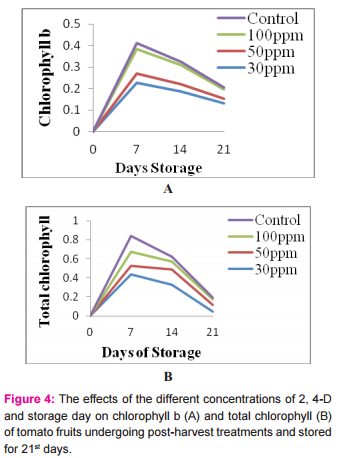
Generally, the quantitative analysis of photosynthetic pigments indicates that, the more accumulation of pigments was observed in 2, 4-D treated fruits. In contrast, control fruit exhibit weaker stimulation on photosynthetic pigments accumulation. In all treatments of tomato fruits, the result showed statistically significant difference observed (P≤0.05). As the current study shows an application of 2, 4-D on tomato fruit simultaneously delayed the degradation of chlorophylls pigments (degreening) and delays the ripening process of tomato fruits.
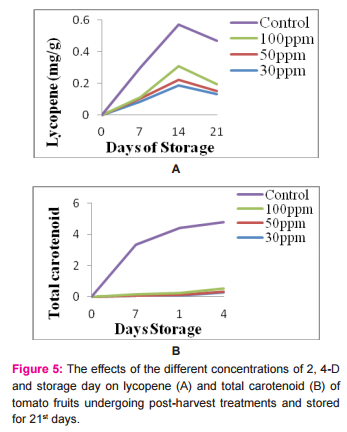
Effects on Lycopene, Total Carotenoids and Sugar Contents On the 7th day of storage, significant variation was seen in lycopene pigment between the different concentrations of 2, 4-D treatments and their control. The amount of total carotenoid measured in control tomato fruits was significantly higher than that of 2, 4-D treated tomato fruits. The amount of reducing sugar was significantly higher in control tomato fruits than that of 2, 4-D treated tomato fruits, and significant different was observed between the different concentrations of 2, 4-D (Figure 6). On the 14st day of storage, significant difference was seen in lycopene pigment between the different concentrations of 2, 4-D treatments and their control.
The amount of total carotenoid measured in control tomato fruits was significantly higher than that of 2, 4-D treated tomato fruits. The amount of total carotenoid measured at the higher concentrations of 2, 4-D was significantly lower than the two lower concentrations. The amount of reducing sugar was significantly higher in control tomato fruits than that of 2, 4-D treated tomato fruits (Figure 6). On the 21st day of storage, significant difference was seen in lycopene pigment between the different concentrations of 2, 4-D treatments and their control.
The amount of total carotenoid measured in control tomato fruits was significantly higher than 2, 4-D treated ones. The amount of reducing sug ar was significantly higher in control tomato fruits than that of 2, 4-D treated tomato fruits (Figure 6). Lycopene and carotenoid are increase gradually with duration of storage Toor and Savage, (2006). Increased levels of lycopene in tomato during storage might be due to ripening advancements of tomato fruits and conversion of chloroplasts to chromoplasts. The increasing in redness of tomatoes during ripening is due to lycopene accumulation, in association with the internal membrane system Toor and Savage, (2006). In general, the increment of total carotenoid as well as reducing sugar contents of treated fruits by 2, 4-D showed that the tomato fruit tends to be ripening stages.
This is due to the breakdown of polysaccharides into water soluble sugar hence increases in the sugar accumulation content as (Neeta et al., 2010). On the 7th day of storage, significant difference was seen in reducing sugar between the different concentrations of 2, 4-D treatments and their control. The quantity of reducing sugar measured at the highest level of 2, 4-D concentrations was significantly higher than the two lower concentrations and significant difference was seen between the different concentrations of 2, 4-D treated tomato fruit. The amount of reducing sugar was significantly higher in control tomato fruits and the result showed significant difference (P≤0.05) between different concentrations of 2, 4-D (Figure 6).
For the day 14th treatments, result also showed significant difference in reducing sugar between the different concentrations of 2, 4-D treatments and their control. The amount of reducing sugar measured at the highest concentration of 2, 4-D was significantly higher than the two lower concentrations by 2, 4-D treatments (Figure 6). Statistically significant difference was observed in total sugar content of tomato fruits treated between the three concentrations of 2, 4-Dand control group on the 7th day of storage. However, high total sugar accumulation was observed at and 30ppm for 2, 4-D concentrations, and low total sugar accumulation was recorded for 2, 4-D at 100ppm, respectively (Figure 6).

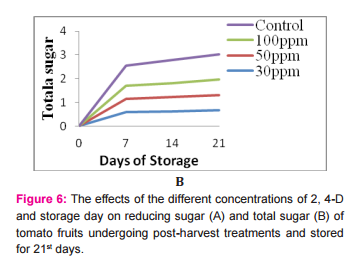
On the14th day of storage, there was highly significant difference in total sugar between the different concentrations of 2, 4-D treated tomato fruits. The amount of total sugar contents was increased in 2, 4-D treated tomato fruits but, it was lesser than that of the control. The treatments of tomato fruit by 2, 4-D, the sugar analysis was found to be lower than that of the control group hence, 2, 4-D treatment of tomato fruits was delayed the ripened and deterioration and have had an important implication in postharvest managements (Figure 6). On the 21st days of storage the amount of total sugar contents was increased in control tomato fruits and less in 2, 4-D treatments.
There was highly significant variation observed between difference concentrations of the treated tomato fruits by 2, 4-D. The higher amount of total sugar content was observed for 2, 4-D 30ppm concentrations. In general, as concentration increases the amount of total sugar content was increased by 2, 4-D treated tomatoes. Starch is completely hydrolyzed into soluble sugar such as glucose; fructose and sucrose as ripening of tomato fruit was carried out throughout the storage. So, author report that the current study indicated that the treatment of 2, 4-D with varying concentrations delay the breakdown of polysaccharides into different sugar molecules hence, it delays the ripening process of tomato fruits.
Effects on Ethylene Production Treatment of tomato fruits with 2, 4-D significantly reduced ethylene production as compared to control throughout the storage periods (Figure 7). In control groups, ethylene concentration found to sharply increase with increasing of storage days. Though not as clear as in the case of control groups, increasing trend was also observed in ethylene concentration with increasing days of storage period in fruits treated with PGH. Generally, fruits treated with different concentration of 2, 4-D produced less ethylene. The result of this study is in line with the work of (Arnold et al., 2005) who reported that the ripening of climacteric fruits exposed to 0.07μLkg- 1 h-1 and 0.11 μLkg-1h-1 of 1-MCP delayed by at least 13 days after treatments.
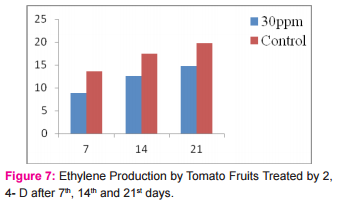
CONCLUSIONS Depending on the data obtained from the study it may be concluded that postharvest application by 2, 4-D treatments is helpful to prevent rapid postharvest loss of tomato up to 21st day. Based on this finding, the following points are recommended:
I. Further research with different concentrations of the same hormones in sole and combinations must be carried out to come up with optimum concentrations that enhance shelf life of tomato fruits.
II. Stakeholders of the area need to be trained about the postharvest treatment and techniques to extending postharvest managements of fruit and vegetable crops.
ACKNOWLEDGEMENT The authors acknowledge Haramaya University and Ethiopian Ministry of education for financing this work. Authors also acknowledge the immense help received form the scholars whose articles are cited and including in references of this manuscript. The authors are also grateful to authors/editors/ publishers of all those articles, journals and books from where the literature for this article has been reviewed and discussed.
References:
1. A.O.A.C. Vitamins and other nutrients (In Official Methods of Analysis (17th edition), Washington, D.C., 2000, 2:16-20.
2. Akbudak, B. and Akbudak, N. Effect of hot water treatment and modified atmosphere packaging on the quality and cold storage life of cherry tomatoes. Journal of Food Science and Technology, 2007, 44:216-219.
3. Andrea, M., Maurizio, V., Hirosh, G. and Silviero, S. Effect of some plant growth regulator treatments on apple fruit ripening. Journal of Plant Growth Regulation, 1999, 25:127–134.
4. Arnold, M., Opiyo, A. and Ying, T.J. The effects of 1-methylcyclopropene treatment on the shelf life and quality of cherry tomato (Lycopersicon esculentum cerasiforme) fruit. International Journal of Food Science and Technology, 2005, 40:665-673.
5. Bhowmik, S.R. and Pan, J.C. Shelf life of mature green tomatoes stored in controlled atmosphere and high humidity. Journal of Food Science, 1992, 57: 948-953.
6. Central Statistical Agency, Agricultural sample survey 2011/2012. Report on area and production of crops (Private peasant holdings, main season). Statistical Bulletin, Addis Ababa Ethiopia, 2011, 01-532.
7. Cheour, F.C.., Willemot, Y., Makhlouf P.M. and Desjardins, Y. Postharvest response of two strawberry cultivars to foliar application of CaCl2 . Horticulture Science, 1991, 26:1186-1188.
8. Esteves, M.T., Carvalho, M.I.F., Chitarra, A.B. and Paula, M.B. Characteristics of fruits of six guava (Psidium guajava L.) cultivars during ripening, Vitamin C and tannins contents. Fruticultural Journal, 1984, 8:490-500.
9. Ibrahim, F.E. Effect of postharvest treatments on storage ability and keeping quality of Amar apricot fruits. Annals of Agriculture and Sciences, 2005, 43:849-867.
10. Javid, U. Storage of fresh tomatoes to determine the level of (CaCl2 ) coating and optimum temperature for extended shelf life. Journal of Engineering and Bioprocess Technology, 2009, 2:30-43.
11. Kader, A.A. Postharvest technology of horticultural crops, University of California, Agriculture and Natural Resources, 2002.
12. Lemma, D., Yayeh, Z. and Herath, E. Agronomic studies in tomato. Horticulture research and development in Ethiopia: Proceedings of the Second National Horticultural Workshops of Ethiopia. Addis Ababa, Ethiopia, 1992, pp 163.
13. Lester, G.E. and Grusak, M.A. Postharvest application of calcium and magnesium to honeydew and netted muskmelons: effects on tissue ion concentrations, quality and senescence. Journal of America Society and Horticultural Sciences, 1999, 124:545-552.
14. Macheix, J. J., Fleuriet, A. and Billot, J. Fruit phenolics. Boca Raton, FL: CRC Press, 1990, pp. 1–126.
15. Nagata, M. and Yamashita, I. Simple method for simultaneous determination of chlorophyll and carotenoids in tomato fruit. National Research Institute of Vegetables, Ornamental Plants and Tea, 1992, 360:514-23.
16. Naika, S., Jeude, J. L., Goffau, M., Hilmi, M. and Dam B., Cultivation of Tomato: Production, Processing and Marketing. Agromisa Foundation and CTA, Wageningen, the Netherlands, 2005, 2:6-92.
17. Neeta, N.P., Gol B. and Ramana, T.V. Effect of postharvest treatment on physicochemical characteristics of and shelf life of tomato fruits during storage. American-Eurasian Journal of Agriculture and Environmental Sciences, 2010, 9:470-479.
18. Pretel, M.T., Serrano, M., Amoros, A., Riquelme, F. and Romojaro, F. Non-involvement of ACC and ACCoxidase activity on pepper fruit ripening. Post-harvest Biology and Technology, 1995, 5:295-302.
19. Sapers, G.M., Douglas, F.W.J., Ziolkowski, M.A., Miller R.L. and K.B. Hicks, Determination of ascorbic acid, dehydroascorbic acid and ascorbic acid-2-phosphate in infiltrated apple and potato tissue by high-performance liquid chromatography. Journal Chromatograph, 1990, 503:431-436.
20. Seyoun, T. The improvement of the shelf Life of vegetables through pre and postharvest treatment. Ph.D. Dissertation presented to the University of Free State. South Africa, 2002, 2:260- 270.
21. Sudha, R., Amutha, S., Muthulaksmi, W., Baby, R., Indira K. and Mareeswari, P. Influence of pre and postharvest chemical treatments on physical characteristics of sapota (Achrassapota L). Journal of Agriculture and Biological Sciences, 2007, 3(5):450-452.
22. Tekalign, T. Response of potato to paclobutrazole and manipulation of reproductive growth under tropical condition. Ph.D. Dissertation presented to University of Pretoria, South Africa, 2005, 3:95-105.
23. Toor, R.K. and Savage, G.P. Changes in major antioxidant components of tomatoes during post-harvest storage. Journal of Food Chemistry, 2006, 39:724-727.
|






 This work is licensed under a Creative Commons Attribution-NonCommercial 4.0 International License
This work is licensed under a Creative Commons Attribution-NonCommercial 4.0 International License